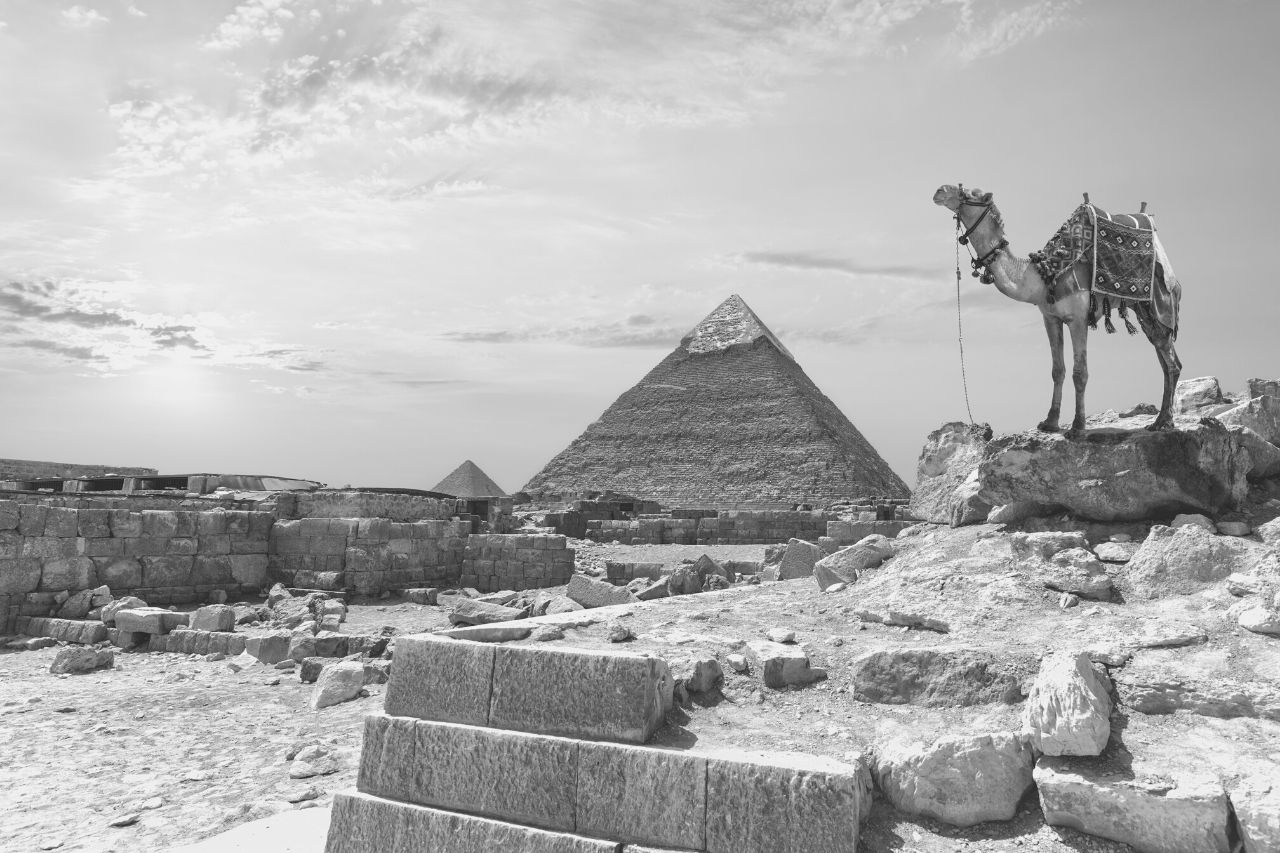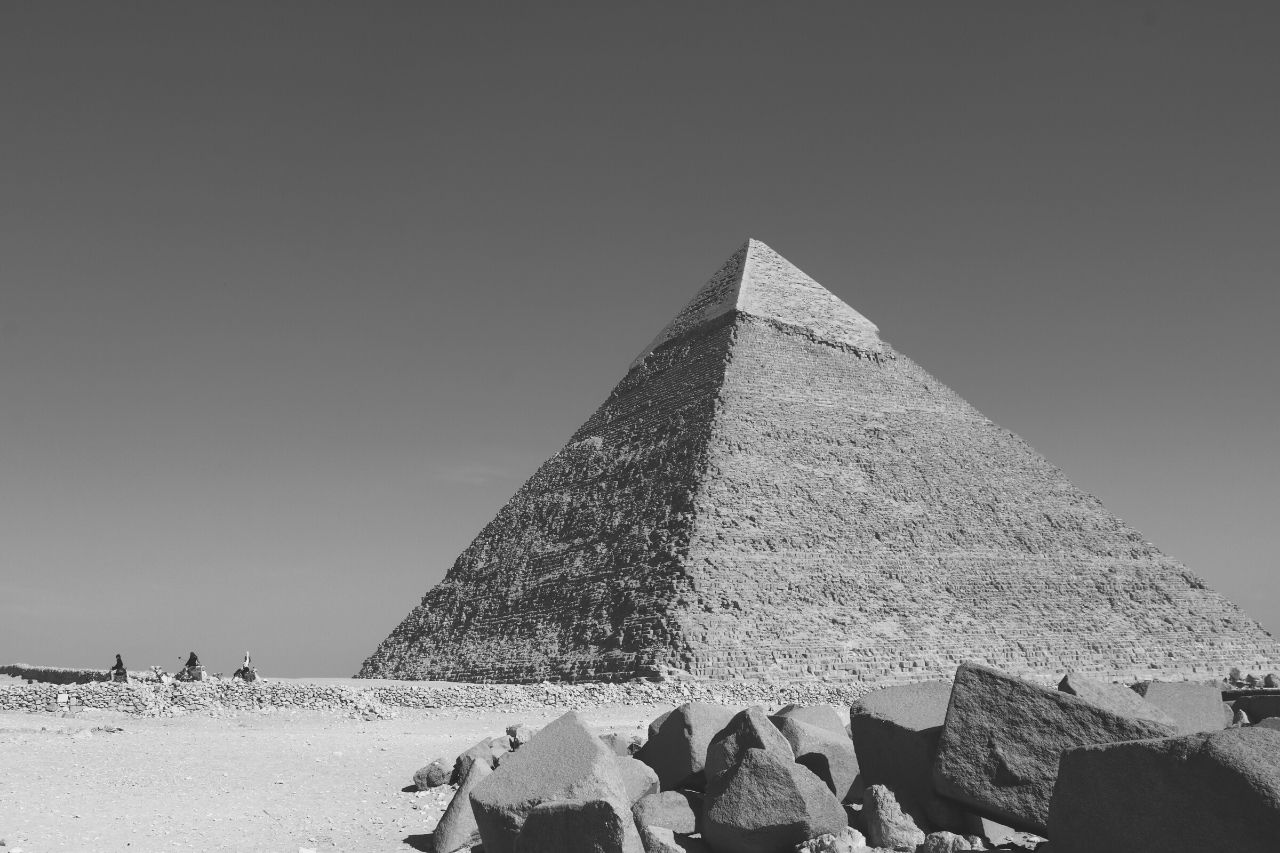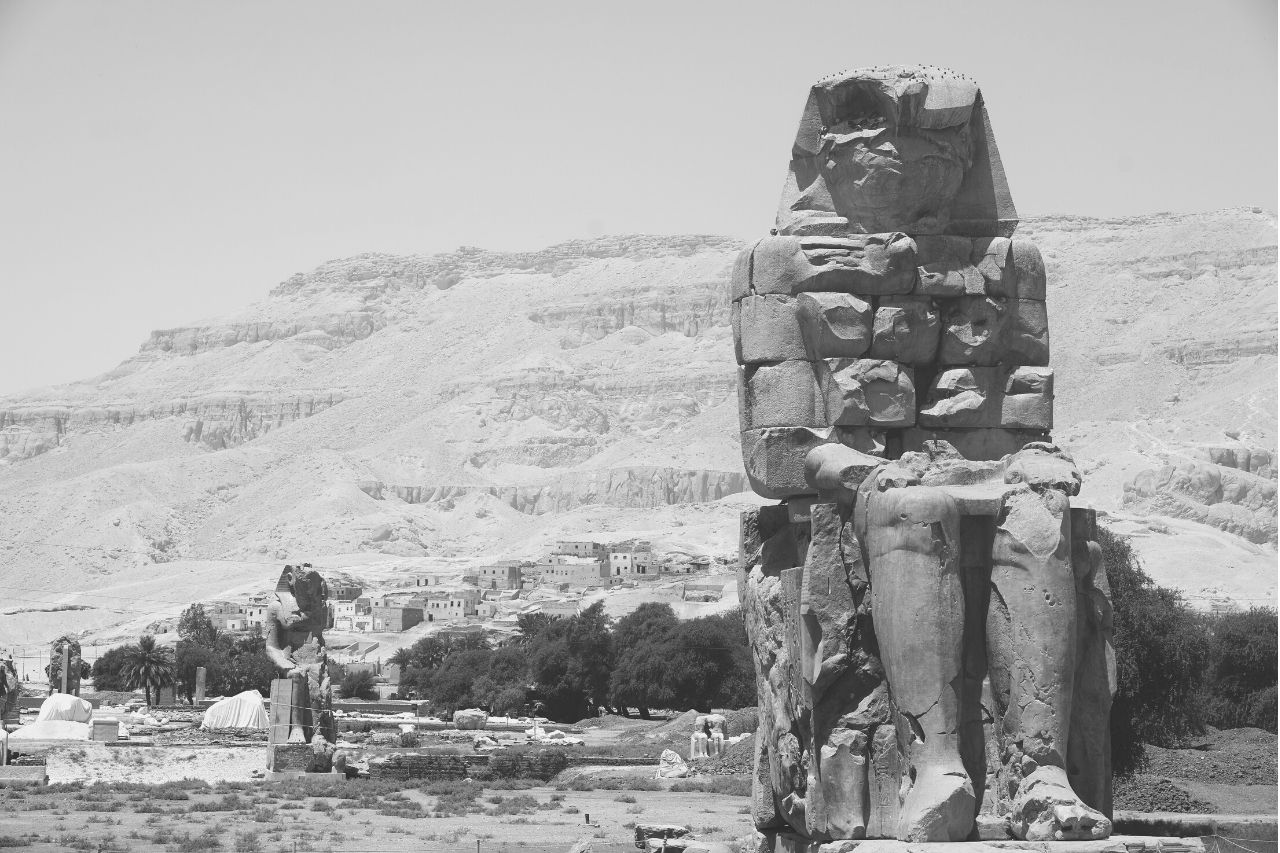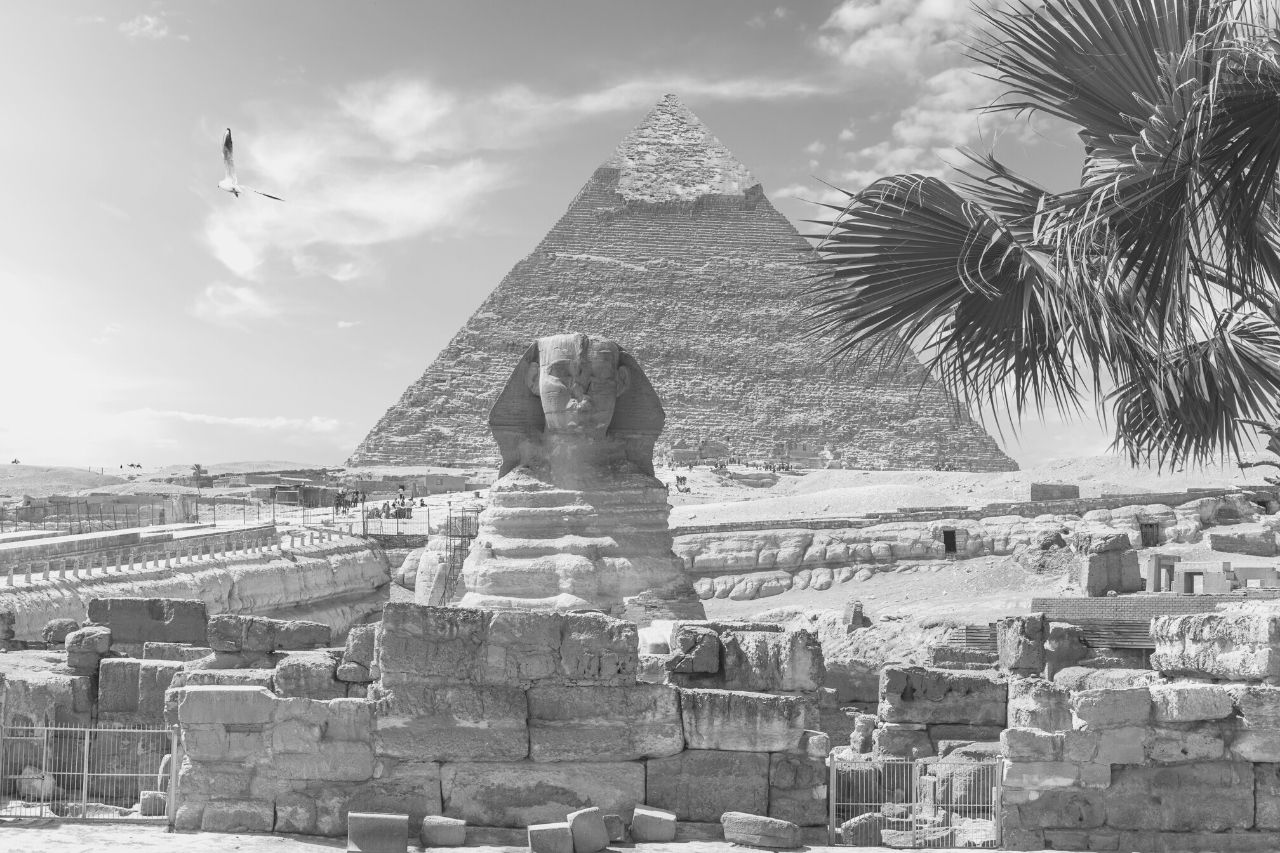Pyramid of Khafre: An Eternal Home for Khafre’s Mummy
The Pyramid of Khafre is located in Giza, on the outskirts of Cairo, known as being the home of the remarkable ancient Egyptian pyramids. Several of the Giza pyramids are among the world’s most significant buildings.
The Pyramid of Khufu is Egypt’s tallest structure and was built by Khafre’s father. Also known as the Great Pyramid, the Pyramid of Khufu is the last remaining of the Seven Wonders of the Ancient World.
Khafre, Khufu ‘s second son, ruled ancient Egypt during the 4th Dynasty and commissioned the construction of the tomb of Khafre, the second great pyramid of Giza. A portion of outer limestone casing stones, similar to those that would have initially encased all three Great Pyramids, can be seen at the very top of the Pyramid of Khafre. Although it looks more significant than his father’s memorial, it is smaller but sits 33 feet higher on the Giza plateau.
Egyptian pyramids are said to be modeled after the initial mound from which the Egyptians believed the earth was formed. Most pyramids were constructed with polished, reflective white limestone to give them a bright look when viewed from afar, to further provoke the image of the Pyramid as symbolic of the sun’s falling rays.
The ancient Egyptians believed the physical doorway into the heavens was the black expanse of the sky at night which gave the illusion that the stars appear to orbit around the structure. One of the small shafts that extend from the main burial chamber through the Great Pyramid’s body aims straight at the middle of the sky. It implies that they built the Pyramid intending to launch the deceased pharaoh’s spirit into the home of the gods.
Pyramids were not constructed in isolation; they were part of a complex that included various ritualistic elements such as a temple, cemetery, and chapel. Funerary relics have been discovered at Giza that significantly indicate the Pyramid’s purpose in ancient Egyptian culture.
Inscriptions known as the Pyramid Texts are a substantial source of knowledge on Egyptian religion and are found on the walls of the 5th and 6th Dynasty pyramids. However, due to the lack of historical documents, and surviving first-person interpretations, it is difficult to precisely know what all the buildings in the pyramid complex were used for or how the specific burial processes were carried out.
The Khafre Pyramid is interesting for this purpose due to the attributing buildings surrounding the Pyramid, their former use, and what they symbolize. Let’s dig into more details on the history of the Khafre Pyramid below.
Khafre's Pyramid
The Pyramid of Khafre is physically located a few hundred feet southwest of the Great Pyramid of Giza. It’s on the Giza Plateau, a limestone plateau southeast of Cairo that’s almost entirely encircled by modern Cairo’s city and surrounding suburbs.
The Pyramid of Khafre stands 469 feet tall with a square base of 705 feet, and it is the centerpiece of the pharaoh’s funerary complex, constructed to equal that of his father’s (Khufu or the Great Pyramid). A sculpture of Khafre in the image of a Sphinx stands at a distance to the Khafre Pyramid. It is a one-of-a-kind sculpture with its interpretive meaning outside of its association with the Great Pyramid of Khafre.
The Pyramid features the same limestone outer casing initially used to cover all three pyramids in Giza. Today, this exterior limestone can only be found on top of the Pyramid of Khafre. The base of the Pyramid of Khafre is just 50 feet shorter than the Great Pyramid, and though Khafre’s Pyramid appears to be larger, this is an optical illusion as the difference in height is only 10 feet.
Khafre appears to dominate the famous Giza plateau, where two other pyramids are located. However, it is smaller than the Great Pyramid constructed by his father. This impression is because it is built on rocky terrain, so the summit is higher but is much smaller than his father’s Great Pyramid.
One idea is that the Pyramid was supposed to be much larger, intending to locate the northern base 98 feet farther north, ensuring Khafre’s Pyramid would be significantly larger than his father’s. The entrance inside the Khafre pyramid to the lower descending corridor would have been hidden within the Pyramid’s brickwork.
While the Pyramid’s north side is cut away from the Pyramid more on the north side than on the western side, it is unclear whether there was enough room on the plateau for the limestone enclosure wall, as is consistent with the surrounding pyramid construction techniques. However, like with other surrounding pyramids, plans were likely altered during construction, and the entrance was relocated.
Another distinction is that Khufu’s Pyramid, the Great Pyramid, was constructed on flat and level land. However, the Pyramid of Khafre began upon a tiny hill buried beneath a mountain, which provided material for constructing the Great Pyramid of Khafre.
The issue with this approach was that the Pyramid base was not on a flat surface, but an inclined one and that surface was not stable enough for the Pyramid to stand erect, as it has for centuries. The ancient Egyptians devised a way to stabilize the base by carving into the hill and cutting stone blocks to match the length of the many terraces that comprised the Pyramid. As a result, after a given number of layers, they achieved a completely flat surface.
Who Discovered the Pyramid of Khafre?
During the First Intermediate Period 2181-2055 BC, the Pyramid was most likely discovered and opened to be plundered. Tomb robbers seeking to uncover the treasures of the pharaohs in their ancient temples entered the temple of Khafre seeking relics.
Later, the limestone cladding that remains only at the top of the Pyramid today was collected for Ramesses II‘s temple in Heliopolis during the 18th Dynasty in Egyptian history regarded as the New Kingdom, approximately 1570-1544 BC.
On March 2, 1818, an Italian explorer named Giovanni Belzoni uncovered the original entrance to the Great Pyramid of Khafre on the north side of the Pyramid. Belzoni is recorded as the first person in modern antiquity to have gone inside the Khafre Pyramid.
Belzoni hoped to discover the tomb of Khafre, but the room considered to be the burial chamber was empty save for an open sarcophagus on the floor with a shattered lid. Several Egyptologists and historians have examined the monument, but British anthropologist John Perring performed the first comprehensive examination of the Pyramid of Khafre in 1837.
French archaeologist Auguste Mariette partially excavated Khafre’s valley temple in 1853, also known as the western cemetery associated with the Pyramid of Khafre. When clearing it out in 1858, Mariette discovered a statue of Khafre. Countless artifacts from Mariette’s expeditions in Egypt now live at the Louvre in Paris.
Inside the Pyramid of Khafre
Despite the presence of a sarcophagus, there are no identifiable inscriptions inside the tomb that prove Khafre was ever buried there. The Khafre Pyramid inside comprises a single burial chamber, one tiny secondary chamber, and two corridors.
The inside is significantly scaled-down in comparison to the Great Pyramid - Khufu’s Pyramid - nearby. However, where the Pyramid of Khafre stands alone is in the relics held within the mortuary temple at the Pyramid’s foot. The temple was more elaborate than Khufu’s and, at a time, was teeming with royal art and artifacts. Evidence from expeditions to Khafre’s Pyramid indicates that it once held 52 life-size statues of Khafre.
Khafre’s Pyramid, like the Great Pyramid, is erected on a rocky outcropping into which the underground rooms are carved. The stone used to encase the lower levels of the Pyramid was pink granite, while the upper parts were clad with limestone, some of which is still visible at the peak of the Pyramid.
Unfortunately, the pyramidion, or the golden piece placed at the top of the Pyramid, is gone. The remaining stone encasing the edges is not straight, which could be attributed to the monument settling over time or the blocks being trimmed at the last minute to fit together.
Another unique element to the Pyramid of Khafre is the valley temple of Khafre, located at the east end of the earthen path that extends from the pyramid base. It was built of granite and contained insight into the purpose of the structure. Remaining within the temple is the base or pedestals of 24 statues that once held depictions of the ancient pharaohs.
The Great Sphinx, which stands adjacent to the path connecting Khafre’s valley temple and the mortuary temple, is Egypt’s first genuinely gigantic sculpture. The distance and correlation between the purpose of these structures indicate the enormous carving of a reclining lion with a king’s head was created as a sculpture of Khafre.
The lion was a regal emblem and a symbol of the horizon. The connection between the image of a strong animal and the pharaoh’s head was repeated in Egyptian history. However, none is as prominent as in the depiction of Khafre. The king’s head is smaller than the rest of the body. It is because of the type of stone available to the sculptures, who compensated for the proportion by lengthening the body.
A second temple dedicated to the worship of the Sphinx stands just in front of the Great Sphinx associated with Khafre. However, little is known about the second Sphinx as Old Kingdom writings do not mention the Sphinx or its temple.
The temple features granite pillars creating a colonnade surrounding a central courtyard, comparable to Khafre’s funerary temple or western cemetery. Although, it is unusual that it contains two sanctuaries, one on the east and one on the west, which is thought to be linked to the rising and setting sun.
Who Was Khafre?
Khafre was the brother of Djedefre and the son of Khufu, the namesake of the Great Pyramid in Giza and Queen Henutsen. Queen Khamerernebty I and Queen Meresankh III were Khafre’s two most essential spouses during his time as pharaoh. His son Menkaure became his successor.
He built Giza’s second-biggest Pyramid known as Khafre the Great and is known for being attributed to the Sphinx, which was sculpted to resemble the pharaoh during his time. Many sculptures of Khafre have been uncovered, indicating his reign encouraged the development of art and sculpture, even if for ceremonial purposes.
The Funerary Temple of Khafre
Khafre’s Pyramid’s funerary temple was constructed using massive pieces of limestone, with interior walls covered in granite and an alabaster floor. A small corridor extends inward from the entryway, and there are two chambers on the south end of the temple. Columns adorn the hallways and lead to four other rooms likely used for storage. At the end of the most extended hallway is a stairway that leads to the roof or the Pyramid’s peak.
A large court consisting of 14 square columns is reached through an entrance in the hallway’s western wall. Large rectangular pillars that remain within the temple indicate that they once supported a succession of Khafre sculptures that adorned the court.
It was the earliest dated funerary temple to feature all five conventional components discovered in similar funerary temples at the Great Pyramids in Giza. These five components include an entry hall, a court containing many columns, five sculptures of pharaohs, and five storage chambers for relics or items needed in the afterlife.
Evidence that at least 52 life-size sculptures of Khafre remain within the temple today; however, historical evidence suggests that during the reign of Ramesses II, these were destroyed and “recycled.” Many of the statues of Khafre were stripped of his name and replaced with that of Ramesses II.
The Valley Temple or Western Cemetery of Khafre
The funerary temple is also referred to as the western cemetery. It is also associated with Khafre and connected by a 1621 feet pathway that runs from the Pyramid and past the Great Sphinx depicting Khafre. It was constructed of massive red granite stones, and like the interior of the funerary temple, alabaster was used to pave the floor and inner walls of several of the rooms. Even though its exterior walls are worn, the valley temple has sustained the hands of time better than the funerary temple of Khafre.
Two doors on the eastern wall of the Valley Temple opens to a corridor that runs north to south. This corridor once included large sculptures of Khafre, and a doorway leads west into another hall with 16 solid granite pillars supporting the ceiling. There are 23 Khafre sculptures placed in the floor sockets. Each remains except for one, which has been removed. Furthermore, it is unknown by whom and where the depiction of the great pharaoh is presently located.
From the way the Valley Temple was designed, its purpose was so that light could enter the temple through tiny openings in the ceiling, illuminating the statues. A small corridor in the southwest corner of the hall leads to a two-level collection of storerooms. The lowest levels are made of highly polished red granite, while the upper levels are made of alabaster.
Conclusion
From the 4th to the 6th Dynasties, pyramid construction was at its peak. For more than a thousand years, smaller pyramids were constructed. Hundreds have been uncovered. However, the bones and evidence of their creators of many more pyramids are likely still buried beneath the sand.
Later, monarchs were buried in secret tombs carved into rock cliffs. It became evident that the pyramids did not provide security for the mummified remains of the pharaohs and were increasingly easy targets for grave robbers. Although the majestic pyramids did not safeguard the remains of the Egyptian rulers who constructed them, the names and legends of those monarchs have survived to this day.
While the Pyramid of Khafre may not be the greatest of the pyramids in ancient Egypt, the Pyramid of Khafre is impressive for its history and related outbuildings. Let’s review five things you may not have known about the Pyramid of Khafre:
The Great Pyramid of Khafre is the second largest Pyramid in Egypt and was built by the son of Khufu, whose Pyramid is the largest of the pyramids in Giza. It only appears to be more significant because it was constructed on a higher elevation.
Khafre only ruled as pharaoh in Egypt for 24 years. Historians debate his accomplishments during his time other than the Pyramid and the depiction of himself as the Sphinx.
The limestone seen at the top of the Khafre Pyramid has once encased the entire Pyramid and others in Giza.
The walls of the Pyramid are not flat. They appear to lean inward, which is attributed to natural causes such as erosion and a large earthquake in the 14th century.
The Great Sphinx, sculpted in the image of Khafre, depicts the pharaoh as Horus, the god of offerings to the sun.
Now you know all the historical facts about the ancient Pyramid of Khafre, including its construction and purpose as a religious temple. After learning all this, would you visit the Pyramid of Khafre?














